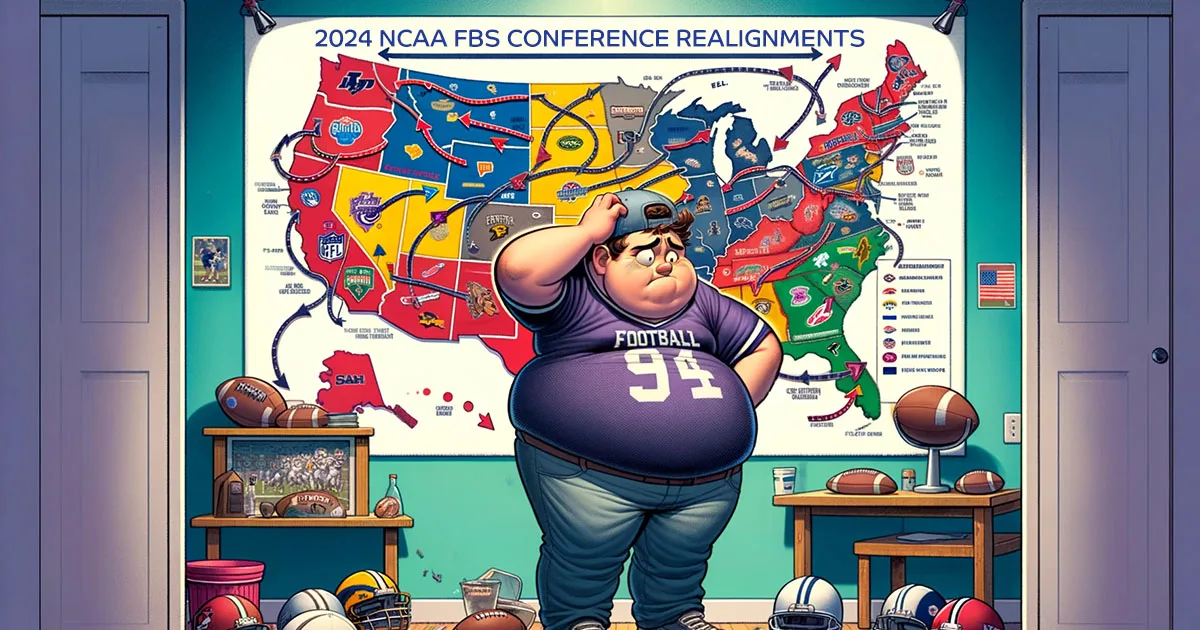
In a seismic shift that has rattled the foundations of the NCAA Division I Football Bowl Subdivision (FBS), the 2024 season heralds an era of unprecedented realignment, toppling traditional power structures and redrawing the collegiate football map.
Implications of 2024 NCAA Conference Shake-ups Beyond the Field
The NCAA FBS conference realignments listed below transcend the playing field, impacting media rights, recruitment patterns, and fan loyalty. The creation of superconferences, driven by financial imperatives, heralds a new dawn of competitiveness and fiscal strategy in college football, challenging the very ethos of collegiate athletics. As a result, the conference changes in 2024 are not just a mere reshuffle; they’re a full-blown revolution.
The SEC’s Power Play
The Southeastern Conference (SEC) bolsters its might with the addition of Oklahoma and Texas, poaching these juggernauts from the Big 12. These additions to the SEC will undoubtedly strengthen its dominance of the NCAA FBS.
Big 12’s Reinvention
In a bold countermove, the Big 12 replenishes its ranks by absorbing BYU, Cincinnati, Houston, and the University of Central Florida (UCF) in 2023, followed by a daring expansion in 2024 with Arizona, Arizona State, Colorado, and Utah. The transformation creates a national identity, moving away from its original focus on the state of Texas and the Midwest.
The Big Ten’s Supercharged Expansion
The Big Ten morphs into a divisionless, 18-team superconference, roping in West Coast giants Oregon, UCLA, USC, and Washington. This expansion transcends geographical boundaries, setting the stage for marathon programming and intensifying the conference’s nationwide appeal. Will these additions finally allow the Big Ten schools to win national football championships on par with the SEC? Don’t count on it, as the SEC will be welcoming powerhouse football programs Oklahoma and Texas to its ranks in 2024. One has to wonder if Michigan and Ohio State can maintain their dominance of the Big Ten with the addition of these top West Coast football programs. Hell no, is my answer to that.
The era of Ohio State and Michigan’s dominance in Big Ten football has come to an end, and this is a good thing for the conference.
ACC’s Dual Strategy
The Atlantic Coast Conference (ACC) doubles down by welcoming California (Cal), Stanford, and Southern Methodist University (SMU), enhancing its football clout while diversifying its athletic portfolio. This growth spurt, while diluting its basketball heritage, marks a strategic pivot towards a more rounded athletic Conference USA
American Athletic Conference
SMU will leave for the ACC, and the conference will add Army. Six schools from Conference USA moved to the AAC in 2023: Charlotte, Florida Atlantic University (FAU), North Texas, Rice, University of Alabama at Birmingham (UAB), and University of Texas at San Antonio (UTSA).
Conference USA
Kennesaw State moves up from the FCS play to join the conference in 2024. Charlotte, Florida Atlantic University (FAU), North Texas, Rice, University of Alabama at Birmingham (UAB), and University of Texas at San Antonio (UTSA) moved from Conference USA to the American Athletic Conference in 2023. Conference USA also added New Mexico State, Liberty, Sam Houston, and Jacksonville State in 2023.
The Biggest Loser: Pac-12 at the Crossroads
The departure of Oregon, UCLA, USC, Washington, Cal, and Stanford plunges the Pac-12 into existential peril. With the only two remaining teams, Oregon State and Washington State, eyeing greener pastures, the Pac-12 teeters on the brink, potentially ending a storied chapter in college sports. Who would have ever imagined this storied college football conference vanishing from the face of the earth? Well, it’s likely to happen unless the Pac-12 conference heads can pull a rabbit out of the hat.
The bottom line to this story is money–it’s all about the money.
This scenario highlights the commercial nature of college sports, where financial considerations often override traditional loyalties and geography. College sports, especially football, generate significant revenue from television rights, merchandise, and ticket sales. Therefore, the schools that have chosen to leave the Pac-12 are likely seeking more lucrative opportunities in conferences that offer greater media exposure and higher revenue from television deals.
In summary, the 2024 NCAA FBS conference realignments that bring a potential dissolution of the Pac-12 as a major player in college football is a reminder of the growing commercialization and financial pressures in college sports. As such, there is nothing left that is sacred when the all-mighty dollar rules the day.
Related Links
2023-2024 NCAA FBS Head Coaching Changes
NCAA Football Recruiting Calendars 2023-2024 [Simplified]